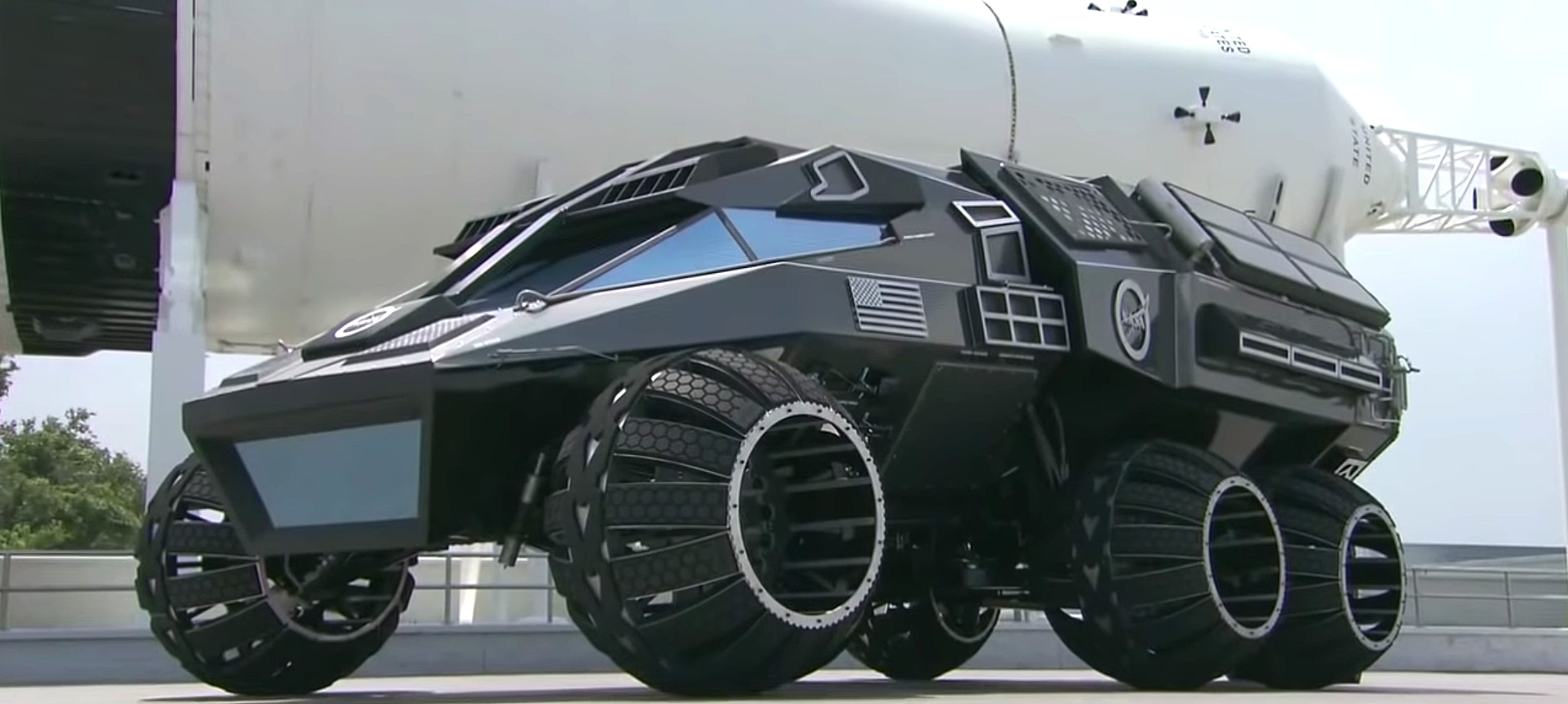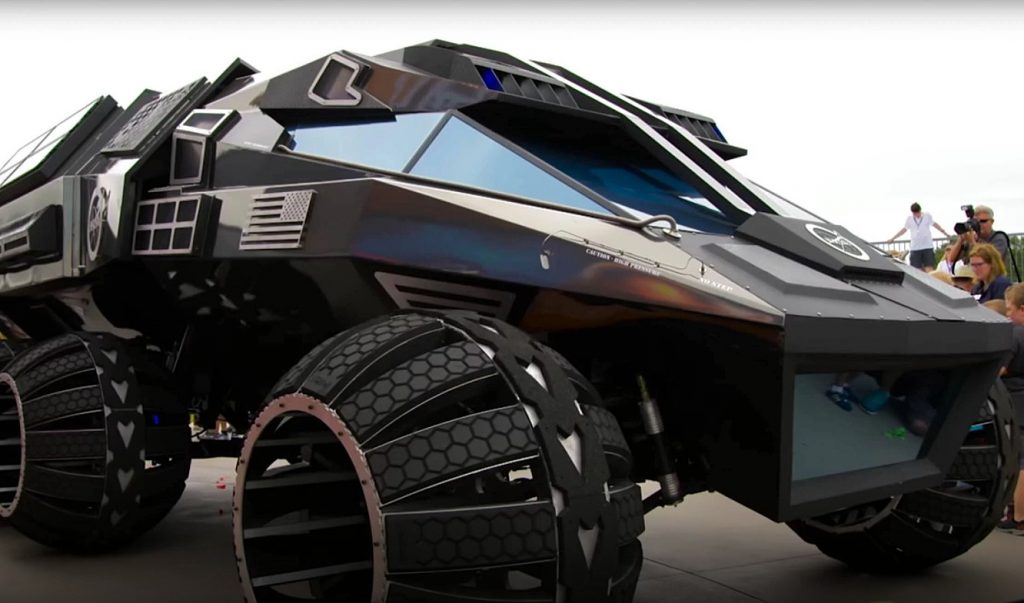

News
Tesla Cybertruck sure looks similar to NASA’s Mars rover concept
Elon Musk’s “Blade Runner” Cybertruck may only be a couple days away from being unveiled to the world, but the vehicle, from its final specs and design, remains a mystery. The Tesla CEO has stated that the vehicle will not look like a traditional pickup truck, and this has been confirmed by teasers from the company and clever Easter Eggs hidden in the CYBRTRK event’s invitation and the vehicle’s stylized logo.
Considering that Musk has stated that the Tesla Cybertruck will look like an armored personnel carrier (APC) from the future, it’s difficult to not see the potential similarities between the vehicle and NASA’s Mars Concept Rover, which was unveiled back in 2017. NASA’s Mars Rover concept looks a lot like an APC from the future, and it looks very tough. It’s massive at 28 feet long, its ground clearance is no joke, and its modular structure allows it to perform a variety of tasks on the harsh environment of the Red Planet.

Quite interestingly, Tesla’s CYBRTRK seems to have some design cues that may very well be similar to that of NASA’s Mars Rover Concept. Tesla’s Easter Eggs show the Cybertruck with a smooth sloping hood, high ground clearance, and an APV-like silhouette. The similarities between the two vehicles’ design (at least based on what Tesla’s Easter Eggs have shown so far) are so notable that one can’t be faulted for speculating that the CYBRTRK may be used by Elon Musk’s companies not just as a disruptive pickup on Earth; it may also be used as a basis for a potential SpaceX Mars Rover.
This sounds very much like a statement from a sci-fi novel, but considering Musk’s habit of doing the unorthodox and implausible, a double-purpose heavy-duty vehicle may actually make sense. Musk likely prefers to have as much overlap between Tesla and SpaceX’s technologies, after all. Last September, for example, Musk stated that Teslas have the potential to work in other planets. “Well, actually, Teslas will work on Mars. You can just drive them, pretty much, because electric cars don’t need oxygen, they don’t need air. So you can just drive them around, no problem,” Musk said during SpaceX’s Starship Q&A session.
That being said, creating a crewed Mars Rover from the CYBRTRK’s platform would be incredibly challenging. For a Mars Rover project, SpaceX and Tesla would most likely focus on making the vehicle as light as possible. This is due to the Rover being part of a payload that gets sent to space. Payloads are very expensive, and thus, equipment from the CYBRTRK that’s useful on Earth will likely not be relevant for a vehicle designed for Mars. Performance is also pretty irrelevant in a crewed rover. If Tesla were to design a crewed Mars rover based on the Cybertruck, it would have to create massive modifications to the vehicle in itself, from its battery cooling systems to its equipment.
This, of course, would be a pretty challenging endeavor on both Tesla and SpaceX’s part. The difficulties of creating a vehicle capable of traversing a foreign planet from the platform of an Earth-based truck are no joke, after all. Things do get a bit easier if SpaceX ends up using the CYBRTRK platform to create an unmanned Mars Rover.
Tesla has a lot of experience in autonomous driving, and this could play very well into its advantage if Elon Musk’s private space firm decides to deploy unmanned rovers to explore the Red Planet. With this concept in mind, a tough, lightweight vehicle that’s loaded to the teeth with tech and based on the CYBRTRK platform could make sense. Tesla and SpaceX would still have to overcome massive challenges in creating a space-capable land vehicle from a pickup truck platform, but there’s no denying that the electric car maker’s expertise in designing and making EVs can very well make an affordable, reliable unmanned Mars Rover feasible.
Inasmuch as these ideas may sound implausible, it should be noted that a Mars Rover project between Tesla and SpaceX will likely not strain either company. The number of rovers needed for the initial years of a Mars mission, crewed or unmanned, will likely be very small, perhaps an order of magnitude less than the rollout of the original Tesla Roadster. Thus, both companies could innovate to the limit based on the CYBRTRK platform and it would not be a difficulty at all. The size of a CYBRTRK-based rover may not even be much of an issue, provided that SpaceX’s Starship rollout goes off without problems.
Tesla deserves a lot of credit for keeping the CYBRTRK a secret until today. Considering its futuristic cues and Elon Musk’s fond references to the vehicle being a truck worthy of a sci-fi set, the pickup truck may very well be the machine that bridges Tesla and SpaceX, at least to some degree. Even if the only parts of the Cybertruck that can be used for a Mars Rover are its chassis and powertrain, such an overlap will still be incredibly useful. Such ideas are crazy, but they may also be classic Elon Musk.

Elon Musk
Elon Musk and Tesla AI Director share insights after empty driver seat Robotaxi rides
The executives’ unoccupied tests hint at the rapid progress of Tesla’s unsupervised Robotaxi efforts.

Tesla CEO Elon Musk and AI Director Ashok Elluswamy celebrated Christmas Eve by sharing personal experiences with Robotaxi vehicles that had no safety monitor or occupant in the driver’s seat. Musk described the system’s “perfect driving” around Austin, while Elluswamy posted video from the back seat, calling it “an amazing experience.”
The executives’ unoccupied tests hint at the rapid progress of Tesla’s unsupervised Robotaxi efforts.
Elon and Ashok’s firsthand Robotaxi insights
Prior to Musk and the Tesla AI Director’s posts, sightings of unmanned Teslas navigating public roads were widely shared on social media. One such vehicle was spotted in Austin, Texas, which Elon Musk acknowleged by stating that “Testing is underway with no occupants in the car.”
Based on his Christmas Eve post, Musk seemed to have tested an unmanned Tesla himself. “A Tesla with no safety monitor in the car and me sitting in the passenger seat took me all around Austin on Sunday with perfect driving,” Musk wrote in his post.
Elluswamy responded with a 2-minute video showing himself in the rear of an unmanned Tesla. The video featured the vehicle’s empty front seats, as well as its smooth handling through real-world traffic. He captioned his video with the words, “It’s an amazing experience!”
Towards Unsupervised operations
During an xAI Hackathon earlier this month, Elon Musk mentioned that Tesla owed be removing Safety Monitors from its Robotaxis in Austin in just three weeks. “Unsupervised is pretty much solved at this point. So there will be Tesla Robotaxis operating in Austin with no one in them. Not even anyone in the passenger seat in about three weeks,” he said. Musk echoed similar estimates at the 2025 Annual Shareholder Meeting and the Q3 2025 earnings call.
Considering the insights that were posted Musk and Elluswamy, it does appear that Tesla is working hard towards operating its Robotaxis with no safety monitors. This is quite impressive considering that the service was launched just earlier this year.
Elon Musk
Starlink passes 9 million active customers just weeks after hitting 8 million
The milestone highlights the accelerating growth of Starlink, which has now been adding over 20,000 new users per day.

SpaceX’s Starlink satellite internet service has continued its rapid global expansion, surpassing 9 million active customers just weeks after crossing the 8 million mark.
The milestone highlights the accelerating growth of Starlink, which has now been adding over 20,000 new users per day.
9 million customers
In a post on X, SpaceX stated that Starlink now serves over 9 million active users across 155 countries, territories, and markets. The company reached 8 million customers in early November, meaning it added roughly 1 million subscribers in under seven weeks, or about 21,275 new users on average per day.
“Starlink is connecting more than 9M active customers with high-speed internet across 155 countries, territories, and many other markets,” Starlink wrote in a post on its official X account. SpaceX President Gwynne Shotwell also celebrated the milestone on X. “A huge thank you to all of our customers and congrats to the Starlink team for such an incredible product,” she wrote.
That growth rate reflects both rising demand for broadband in underserved regions and Starlink’s expanding satellite constellation, which now includes more than 9,000 low-Earth-orbit satellites designed to deliver high-speed, low-latency internet worldwide.
Starlink’s momentum
Starlink’s momentum has been building up. SpaceX reported 4.6 million Starlink customers in December 2024, followed by 7 million by August 2025, and 8 million customers in November. Independent data also suggests Starlink usage is rising sharply, with Cloudflare reporting that global web traffic from Starlink users more than doubled in 2025, as noted in an Insider report.
Starlink’s momentum is increasingly tied to SpaceX’s broader financial outlook. Elon Musk has said the satellite network is “by far” the company’s largest revenue driver, and reports suggest SpaceX may be positioning itself for an initial public offering as soon as next year, with valuations estimated as high as $1.5 trillion. Musk has also suggested in the past that Starlink could have its own IPO in the future.
News
NVIDIA Director of Robotics: Tesla FSD v14 is the first AI to pass the “Physical Turing Test”
After testing FSD v14, Fan stated that his experience with FSD felt magical at first, but it soon started to feel like a routine.

NVIDIA Director of Robotics Jim Fan has praised Tesla’s Full Self-Driving (Supervised) v14 as the first AI to pass what he described as a “Physical Turing Test.”
After testing FSD v14, Fan stated that his experience with FSD felt magical at first, but it soon started to feel like a routine. And just like smartphones today, removing it now would “actively hurt.”
Jim Fan’s hands-on FSD v14 impressions
Fan, a leading researcher in embodied AI who is currently solving Physical AI at NVIDIA and spearheading the company’s Project GR00T initiative, noted that he actually was late to the Tesla game. He was, however, one of the first to try out FSD v14.
“I was very late to own a Tesla but among the earliest to try out FSD v14. It’s perhaps the first time I experience an AI that passes the Physical Turing Test: after a long day at work, you press a button, lay back, and couldn’t tell if a neural net or a human drove you home,” Fan wrote in a post on X.
Fan added: “Despite knowing exactly how robot learning works, I still find it magical watching the steering wheel turn by itself. First it feels surreal, next it becomes routine. Then, like the smartphone, taking it away actively hurts. This is how humanity gets rewired and glued to god-like technologies.”
The Physical Turing Test
The original Turing Test was conceived by Alan Turing in 1950, and it was aimed at determining if a machine could exhibit behavior that is equivalent to or indistinguishable from a human. By focusing on text-based conversations, the original Turing Test set a high bar for natural language processing and machine learning.
This test has been passed by today’s large language models. However, the capability to converse in a humanlike manner is a completely different challenge from performing real-world problem-solving or physical interactions. Thus, Fan introduced the Physical Turing Test, which challenges AI systems to demonstrate intelligence through physical actions.
Based on Fan’s comments, Tesla has demonstrated these intelligent physical actions with FSD v14. Elon Musk agreed with the NVIDIA executive, stating in a post on X that with FSD v14, “you can sense the sentience maturing.” Musk also praised Tesla AI, calling it the best “real-world AI” today.








